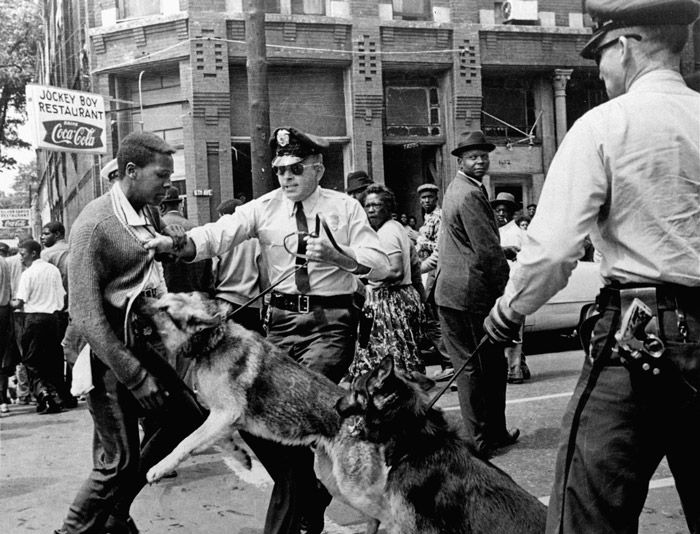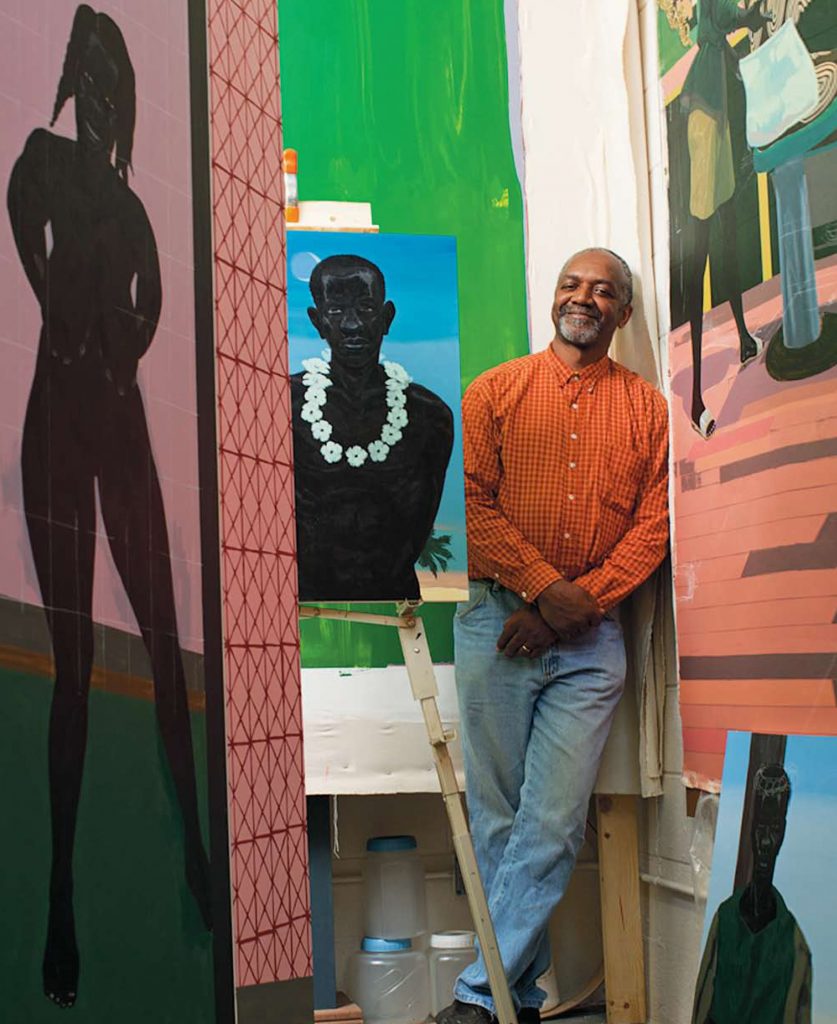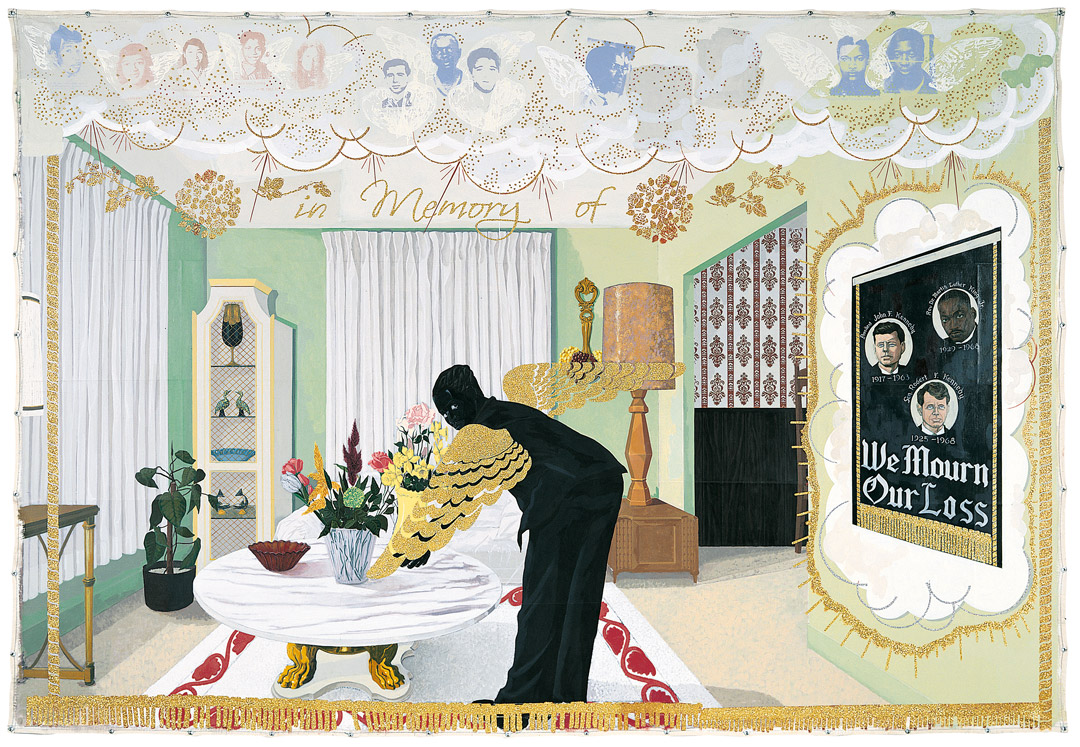Kerry James Marshall
The American Civil Rights Movement began in 1955 in response to the ineffectiveness of lobbying and litigation against racial discrimination. In Alabama in 1960, only 9.1 percent of Black people of voting age in Montgomery County were registered, in comparison to 46.1 percent of the voting age whites. In two other Alabama counties populated predominantly by Black people, none were registered.

Photo: Bill Hudson
This infamous photograph of white officers attacking William Gadsden with a police dog was taken during the Birmingham, Alabama Riot in 1963. The Birmingham Riot was in reaction to targeted bombings at residences associated with Martin Luther King. King was in Birmingham to announce an agreement towards partial desegregation and the economic advancement of black workers. This photo appears in Resist, one of three new paintings by Mickalene Thomas in Figuring History.
The Watts Riot took place in 1965 over six days in reaction to the arrest of Marquette Frye for suspicion of driving while intoxicated. An impoverished neighborhood in South Central Los Angeles, over 14,000 California National Guard troops were mobilized during the riot and a curfew was established in an attempt to restore public order.
"I had to recognize that in that pantheon of old masters, there are no 'black old masters.'"
– Kerry James Marshall

Kerry James Marshall
b.
Marshall was born in , and moved with his family to the in 1963. He holds a BFA from the Otis College of Art and Design and lives and works in Chicago. He is the recipient of several awards, including a 1997 MacArthur Fellowship. A major retrospective of Marshall’s work was recently organized by the Museum of Contemporary Art Chicago (2016), the Metropolitan Museum of Art, New York (2016–17), and the Museum of Contemporary Art, Los Angeles (2017).
Marshall’s paintings, sculptures, collage, video, and photography address issues of Black identity, experience, and representation in . His commanding paintings of recent years combine familiar representational forms, such as the portrait of the artist or the academic life-drawing class, with political references that question historical narratives and dig into presumed truths.
Images: Courtesy of the artist and Jack Shainman Gallery, New York, © Kerry James Marshall, photo: Kendall Karmanian. Souvenir I, 1997, Kerry James Marshall, acrylic, collage, and glitter on unstretched canvas, 108 x 157 in., Collection Museum of Contemporary Art Chicago, Bernice and Kenneth Newberger Fund, 1997.73, © MCA Chicago, photo: Joe Ziolkowski. Vignette #2.75, 2008, Kerry James Marshall, acrylic on PVC panel, 73 ¼ x 61 in., The Art Institute of Chicago, Through prior gift of Adeline Yates; Benjamin Argile Memorial, Cyrus Hall McCormick, Alfred and May Tiefenbronner Memorial, Mr. and Mrs. Frank G. Logan Prize, Pauline Palmer Prize, Broadus James Clarke Memorial, Norman Wait Harris Prize, William H. Bartels Prize, Joyce Van Pilsum, Laura T. Magnuson Acquisition, Ann M. Vielehr Prize, and Ada S. Garrett Prize funds; Flora Mayer Witkowsky Award for American Art; Boles C. and Hyacinth G. Drechney and Mr. and Mrs. J.F. Brower Prize funds; The Municipal Art League Prize for Portraiture; Marjorie and Louis Susman, Martin B. Cahn Prize, and Elisabeth Mathews funds, 2008.481.4, © Kerry James Marshall, The Art Institute of Chicago / Art Resource, NY. School of Beauty, School of Culture, 2012, Kerry James Marshall, acrylic and glitter on unstretched canvas, 108 x 158 in., Birmingham Museum of Art, Museum purchase with funds provided by Elizabeth (Bibby) Smith, the Collectors Circle for Contemporary Art, Jane Comer, the Sankofa Society, and general acquisition funds, 2012.57, © Kerry James Marshall.





